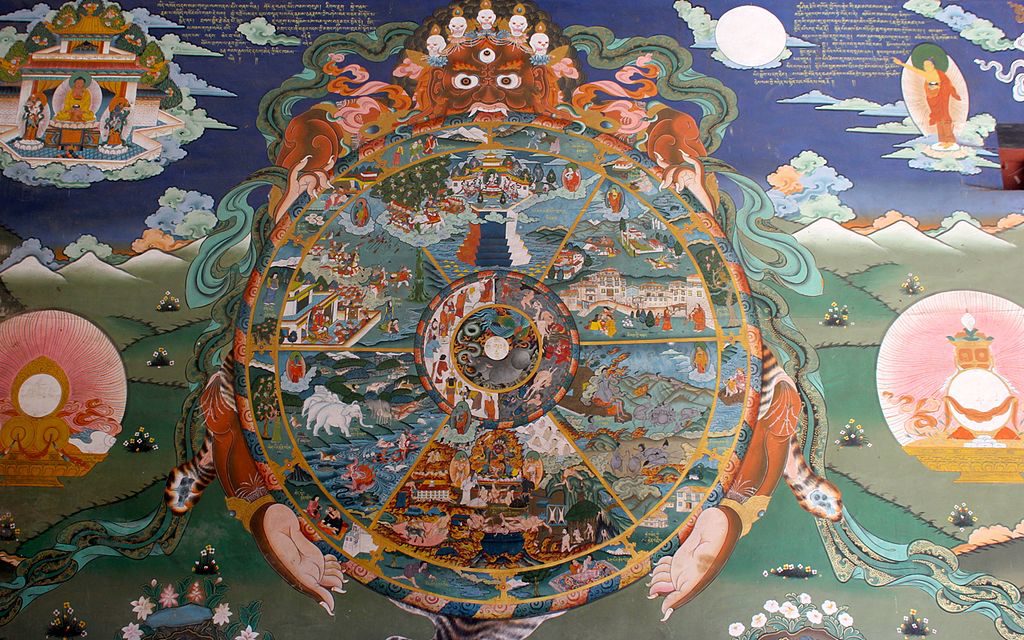The Buddha spoke often of the danger of clinging to views. For example, in the Sabbasava Sutta (Pali Tipitika, Majjhima Nikaya 2), he said that a person can be lost in “a thicket of views, a wilderness of views, a contortion of views, a writhing of views, a fetter of views,” and such a person “is not freed from birth, aging, and death, from sorrow, lamentation, pain, distress, and despair.”
This teaching has led to many misunderstandings, mostly because people cling to views about views. Let’s take a look.
The Metaphysical Misdirection
In several places in the Pali Tipitika, the Buddha declined to answer certain questions. Sometimes, as in the Sabbasava Sutta, he said also there were some questions that aren’t helpful to reflect upon.
Theravadin monk and scholar Thanissaro Bhikkhu says that many of these questions probably were those being hotly debated by philosophers of the Buddha’s day — “Is the cosmos eternal? Is it not eternal? Is it finite? Is it infinite? Is the body the same as the soul? Is the body one thing and the soul another? Does the Tathagata exist after death? Does he not exist after death? Both? Neither?” And after each recitation of such questions, the Buddha would explain that such questions ensnare the questioner in “a fetter of views.”
Some people have interpreted these discourses to mean that the Buddha was not interested in metaphysics. Metaphysics is a word used to mean a lot of things, but primarily it refers to philosophical inquiry into the nature of reality. But many of the Buddha’s teachings are about the nature of reality; on its face, the metaphysics argument makes no sense (see “Buddhism and Metaphysics“).
How Do We Know?
There are several other possible reasons why the Buddha had reservations about some kinds of questions. Some questions might be unanswerable because they are based on mistaken assumptions. For example, the question “is the soul the same as the body” assumes there is a soul.
“Does the Tathagata exist after death” assumes that we all understand what existence and death are, not to mention Tathagata. But usually we don’t. The master teachers tell us that when our understanding ripens, and our understanding of existence and death deepens, we see that the question is meaningless.
Throughout his teaching the Buddha urged his disciples to drop intellectual views and conjecture and instead cultivate direct insight through practice of the Eightfold Path. But for a lot of us, intellectual views and conjecture are the only way we know how to know, and the biggest challenge we face in practice is learning new ways to know.
The Trap of Certitude
Views also become a fetter when they cut off further seeking. Once we are certain we know something, we’re closed off from learning more. Indeed, we humans tend to block out new information that contradicts what we think we know.
And certitude is no guarantee of truth. There’s a saying I heard once — A man with one watch knows what time it is, but a man with two watches is never sure. In this case, wisdom lies with uncertainty.
In Zen Buddhism, teachers refer to beginner’s mind or don’t know mind as a mind that is open to new perspectives.The late Shunryu Suzuki Roshi said, “In beginner’s mind we have many possibilities, but in expert mind there is not much possibility.
Keep in mind also the first two of Thich Nhat Hanh‘s Fourteen Precepts of Engaged Buddhism:
“Do not be idolatrous about or bound to any doctrine, theory, or ideology, even Buddhist ones. All systems of thought are guiding means; they are not absolute truth.
“Do not think that the knowledge you presently possess is changeless, absolute truth. Avoid being narrow-minded and bound to present views. Learn and practice non-attachment from views in order to be open to receive others’ viewpoints. Truth is found in life and not merely in conceptual knowledge. Be ready to learn throughout our entire life and to observe reality in yourself and in the world at all times.”
Many Forms of Clinging
Of course, as long as we live we’re going to have views, and that’s all right. Views are only a problem when we attach to them and are unwilling to let them go. (See also “Why Do Buddhists Avoid Attachment?”)
This brings us to another way “clinging to views” is misunderstood. The Buddha taught his disciples not to cling even to his teachings. He compared Buddhist doctrines to a raft that should be abandoned once the other shore is reached.
Some interpret this to mean the doctrines aren’t that important. If we’re not to cling to them, maybe it’s better to avoid them altogether, right? However, often “avoiding” is just another form of clinging.
The Theravadin monk and scholar Bhikkhu Bodhi writes, “Too often this kind of slippery reasoning provides simply a convenient excuse for adhering, at a subtle level of the mind, to ideas which are fundamentally antithetical to the Dhamma. We hang on to such ideas, not because they are truly edifying, but in order to protect ourselves from the radical challenge with which the Buddha’s message confronts us.”
To paraphrase Thich Nhat Hanh — while the written doctrines may not be absolute truth, they are an essential guiding means. Without that guidance, our old assumptions — assumptions to which we cling without realizing it — go unchallenged. Without that guidance, and the challenge to our assumptions, we are likely to remain lost in a wilderness of views.

